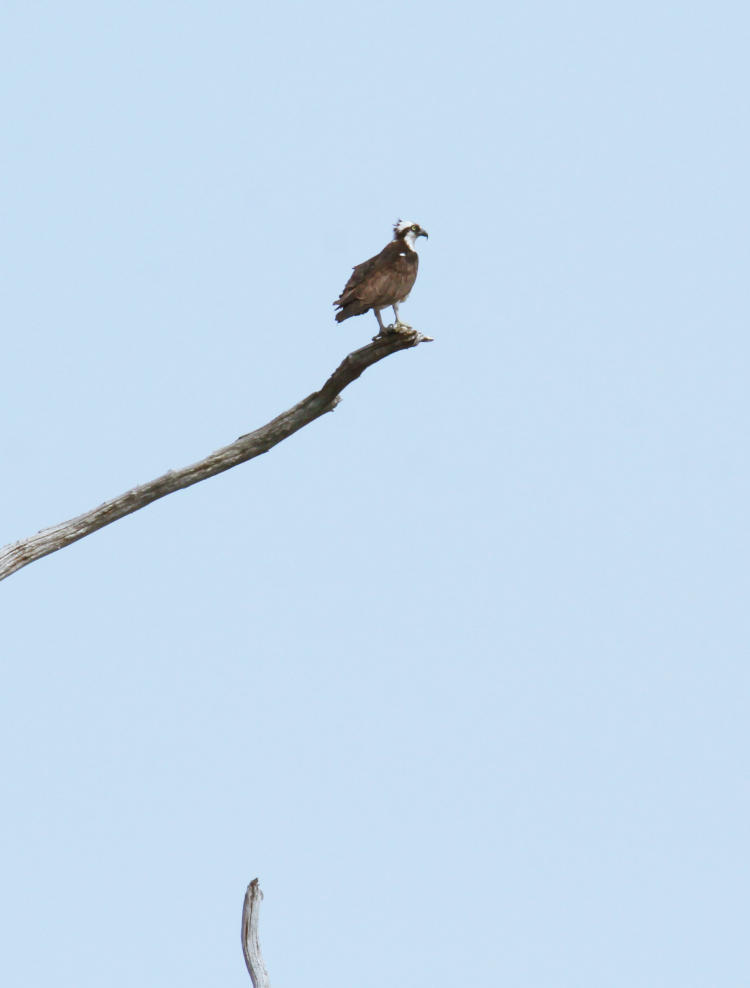
While World Migratory Bird Day yielded just one bird for me, the previous couple of days were a lot more productive, as my brother and I did a short trip out to Washington, North Carolina, and points further east. Here on the waterfront of the town, a nest box for purple martins (Progne subis) shows a lot of activity, in a prime location where there were plenty of riverside bugs to catch. None of the females wanted to give me the clearest looks for illustration, but the males are very deep blue with black wings, while the females more midtone grey with paler bellies, so you can at least tell that there are plenty of couples in residence. Actually, I may be assuming too much about the social structure of martins; this might just be a swingers’ condo. No judgment.

This example here isn’t exactly migratory, tending to remain in the same areas all year long, but it was what I captured on the same trip anyway. Identifying it was a little tricky, given that the hairy woodpecker and the downy woodpecker are almost identical, save for a) the size of the beak, which doesn’t differentiate very much at all; b) some very subtle markings that, like in this photo, aren’t even fully visible; and c) the size, which is fine if you’re close enough or have a solid reference point. I’m going to go with downy woodpecker (Dryobates pubescens) for this one, and a male at that because it appeared to be doing a display for another just out of clear sight behind some foliage, but if someone wants to argue, I’ll cleverly switch the subject over to philosophy just to trash them.
This was in Goose Creek State Park east of Washington, bordering the Pamlico River. An interesting mix of pine forest, swampy wetlands, and largely saltwater sound that yielded the green heron here, it was while wandering the edge of the sound/river that we saw a lone osprey hanging out on a distant dead tree well out into the water.

Its presence there for an extended period of time was a little suspicious, especially given how close it was to an old nest stand that had seen better, or at least more upright, days.

I included the trunk of another tree at the edge of the frame for a reference, to show that I wasn’t being creative with camera angles but holding it dead level. This would initially seem to indicate that the nest platform was long abandoned, but then again, birds nest in the crooks of branches and all that, and sure enough, a very close look at the nest revealed why the osprey was hanging around nearby.

Even at this magnification you have to look closely, but that’s the top of the head and the yellow eye almost dead-center in the frame, the mother sitting on eggs while the father stands watch and fetches food as needed. This was not happening while we were around, though, so no action to catch this time.
Back home, or near it anyway at Jordan Lake, more action was to be found.

The sky was less cooperative later in the day, but the birds were extremely active, and this osprey was circling not too far off and looking about ready to stoop for a fish. When all of a sudden…

… another appeared out of nowhere and dove on the innocent hunter, apparently feeling that this was poaching on its territory, and it was largely through sheer luck that I had the camera to eye at that moment – the second I saw the action I was firing off frames. Timing this would have been next to impossible.

The lower osprey quickly took the hint and dove out of contact, immediately vacating the area, perhaps as surprised as we were – it certainly showed no sign of seeing its attacker coming. While it’s hard to imagine that the victim didn’t sustain some injury from the encounter, it’s hard to say for sure; the feathers are relatively thick there and an osprey might attack another solely for the message, not necessarily to injure them. A lot of wildlife encounters are like that, especially within the same species, and aren’t as vicious as they appear, but the rest is simply speculation.
Off in the distance, a bald eagle (Haliaeetus leucocephalus) performed another harassing encounter on an osprey, which didn’t yield very good pics, but I include this one solely for the curiosity.

Here, I believe it has just completed its attack and is diving for the fish that the osprey had dropped, but what an awkward pose. While I know the back is largely towards us, to the right a bit, and the head is straight down, those wings still have me confused – we’re seeing evidence of a hard maneuver, but the anatomy is not exactly clear here.
We’ll close with a better one.

The late afternoon sun was providing just a little color, and the autofocus nailed things properly, even for the fish. If I knew more about fish species this would probably be enough to identify it, but I don’t and I’m not taking the time. Feel free to chime in if you know.




















































